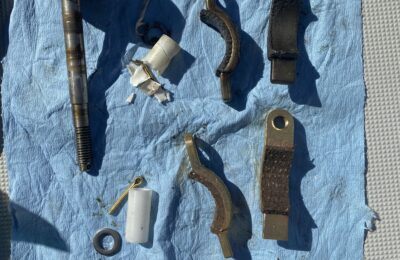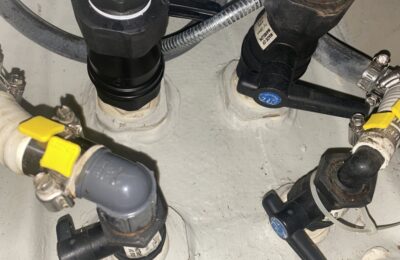Pretty much everything I know at this point about cleaning gel-coat boats is from a week or so I spent last summer trying to bring back a positively chalky 1983 Coronado 15 dinghy. I’m trying to avoid worrying about turning my Ericson into a perfect princess of a boat, because I want to use it for adventures, more than for showing off. However, I’m in the midst of a haul out, and I would feel like I had let myself down if I didn’t make some sort of an effort to make her look sharper when she gets splashed back into the water than when she was hauled out.
Strategy
First, humans are conditioned to be good at noticing contrasts. (Is that a lion in the grass who will eat me for dinner or is it a gazelle I can eat?). The navy blue stripes on the off-white field of my hull present a prime example of contrast. If the line is crisp, it will be visually pleasing. (Corollary: this is why you should never use beige or any middling colors in house you are presenting for sale. I digress.)
Second, oxidation is much easier to see on dark colors than it is on light colors.
I use these two observations to justify trying to clean the dark stripes on my boat, without worrying about the majority of the hull.
Equipment
A $40 Harbor Freight Polisher. “But that will burn out and be a waste!” you say. As someone with the experience of burning through several much more expensive DeWalt Tools, I will offer:
1. If you are pressing on your work surface hard enough to substantially retard the rotation of the polishing head, you are doing it wrong.
2. These electrical motor rotary tools (such as a polisher, or screw driver, or angle grinder) are cooled via an internal air fan that works, sort of, like the impellers that push raw water through your boat engine. If you start to feel the tool heating up, or smell the scent of copper wires being toasted, the right thing to do is NOT stop running the tool, but rather to let it run freely (spin) unrestrained off the work surface. You will feel warm air pouring out of the machine. This is the cooling action. Spin your polisher to cool it off.
-A bunch of wool wheel polishers. Buy a package cheap on-line. You don’t want to stop what you are doing to clean them. They will gum up, quickly or slowly depending how much junk you have to clean off.
A good cutting compound. I tried a number of different automotive ones I had around on my Coronado 15, then did some research, and 3M Heavy Cutting works like magic.
Have a bucket, boat soap, and some towels on hand for cleaning.
Process
0. Do this at a boatyard on a weekend when the employees will be at home and not bothering you about OSHA violations when you use their scaffolding.
1. Wash the area you will work on. Get as much grime and dirt off as you can. You don’t want to rub dirt into your boat.
2. Apply cutting compound to your wool wheel. You might smear some on the boat too. It takes some practice to figure out how much is too much and how much is too little.
3. Run the buffer at the slowest speed with light pressure. Move rapidly to avoid heating up the gelcoat.
4. Wipe off any excess with a terry cloth or microfiber towel.
Before cleaning, Right. After cleaning, Left.
Port side before cleaning, Starboard side after cleaning.
Both sides, both stripes complete
It’s not perfect, but it’s better than when it started, and I think I have snappier stripes now.
The “after” of spinning the wool wheels. About four hours of work total, of which half was spent arranging and dragging scaffolding around, and half was spent actually buffing.



